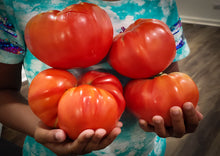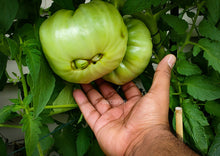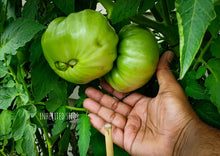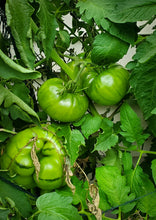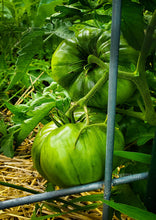
Seeds are inherited and harvested from a Premium Strain of Extra Large Tomatoes average weight of 1.6 to 2 lbs.
Introducing our Heirloom Organically Grown Large Beefsteak Tomato! This delicious and nutritious tomato is the perfect addition to any garden or kitchen.
Our tomatoes are grown using only the finest organic methods, ensuring that they are free from harmful chemicals and pesticides. They are hand-picked at the peak of ripeness, ensuring that they are packed with flavor and nutrients.
Our Large Beefsteak Tomato is an heirloom variety, meaning that it has been passed down through generations of farmers. This tomato can be traced back to the early 1900s, when it was first introduced by Italian immigrants in the United States. It quickly became a favorite among farmers and home gardeners alike for its large size, delicious taste, and high yield.
The Large Beefsteak Tomato is perfect for slicing and serving on sandwiches, salads, or as a standalone side dish. Its large size also makes it ideal for canning and preserving.
Beefsteak is one of the most popular heirloom tomato varieties for the home garden. It is aptly named for the deep red color, large size and meaty texture. They have a classic tomato flavor but with a kick of sweetness and few seed cavities which makes them ideal for culinary uses. They are heavy, sometimes reaching 4 pounds, but most weigh in at about a quarter to one pound in the average home garden. The vines grow vigorously and should be staked or trellised to support their weight.
Growing
Tomatoes are available in a wide variety of shapes, color and sizes. They are broadly classified into two categories:
- Determinate are those that grow to pre-determined height. They are good choices for canning and sauces.
- Indeterminate are those that continue to grow in height and produce fruits throughout the growing season.
Planting
- Select a site with full sun. For northern regions, it is VERY important that your site receives at least 6 hours of daily sunlight.
- Tomatoes will grow in many different soil types, but it needs to be well drained. They prefer a slightly acid soil with a pH of 6.2 to 6.8.
- Start seeds indoors 6 to 8 weeks before the average last spring frost date.
- Two weeks before planting tomato plants outdoors, dig into soil and mix in aged manure or compost.
- Harden off seedlings for a week before planting in the garden. Set young plants outdoors in the shade for a couple of hours the first day, gradually increasing the amount of time the plants are outside each day to include some direct sunlight.
- Place tomato stakes or cages in the soil at the time of planting to avoid damaging roots later on.
Transplants
- Apply fertilizer such as 5-10-5, or 10-10-10 per package instructions. Do not apply high nitrogen fertilizers, as they promote luxurious foliage growth but will delay flowering and fruiting.
- Space tomato transplants at least 2 feet apart.
- Plant the root ball deep enough so that the lowest leaves are just above the surface of the soil.
- If transplants are leggy, bury up to ⅔ of the plant including lowest leaves. Tomato stems have the ability to grow roots from the buried stems.
- Be sure to water the transplant thoroughly to establish good root/soil contact and prevent wilting.
- Newly set transplants may need to be shaded for the first week or so to prevent excessive drying of the leaves.
Care
Watering
- Water generously the first few days that the tomato seedlings or transplants are in the ground.
- Water well throughout the growing season, about 2 inches (about 1.2 gallons) per week during the summer.
- Water in the early morning. This gives plant the moisture it needs to make it through a hot day. Avoid watering late afternoon or evening.
- Mulch after transplanting to retain moisture and to control weeds. Mulch also keeps soil from splashing the lower tomato leaves.
Fertilizing
- Watering in with a starter fertilizer solution will help get the roots off to a good start.
- Side dress plants with fertilizer or compost every two weeks starting when fruits are about 1 inch in diameter.
- If staking, use soft string or old nylon stocking to secure the tomato stem to the stake.
- It is essential to remove the suckers (side stems) by pinching them off just beyond the first two leaves.
Click here to download our free vegetable growing guide
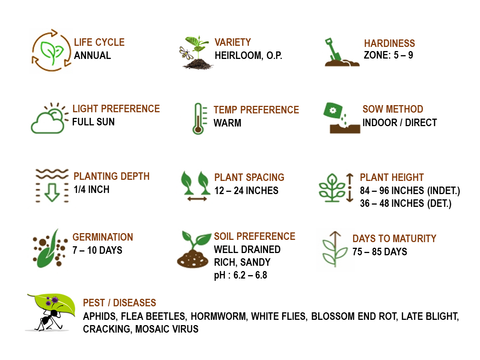
Heirloom, Organically Grown, Large Beefsteak Tomato, Organic farming, Hand-picked, Nutritious, Flavorful, High yield, Vitamin C, Vitamin K, Potassium, Lycopene, Antioxidant







